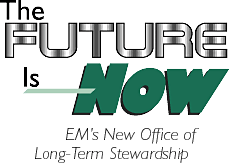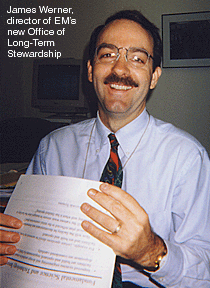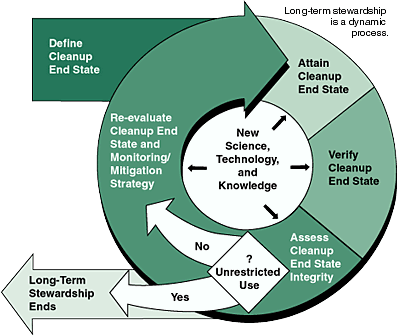
 As the Department of Energy completes
cleanup at its sites across the country, it has begun to implement the "end
state" in the process—long-term stewardship (LTS). DOE expects 108 sites to be
subject to LTS activities by 2070. Because it is not technically or economically feasible
to clean up to levels allowing for unrestricted use, Office
of Environmental Management cleanups will leave residual levels of radioactivity and
other hazards at most sites across the complex. The challenge facing DOE is how to ensure
continued protection of human health and the environment after cleanup projects are
complete. As the Department of Energy completes
cleanup at its sites across the country, it has begun to implement the "end
state" in the process—long-term stewardship (LTS). DOE expects 108 sites to be
subject to LTS activities by 2070. Because it is not technically or economically feasible
to clean up to levels allowing for unrestricted use, Office
of Environmental Management cleanups will leave residual levels of radioactivity and
other hazards at most sites across the complex. The challenge facing DOE is how to ensure
continued protection of human health and the environment after cleanup projects are
complete.
What is long-term stewardship?
All activities necessary to ensure sustainable protection of human health and the
environment after cleanup, disposal, or stabilization is completed. |
To address the need for ongoing management of DOE sites after closure, the
assistant secretary for EM, Dr. Carolyn Huntoon, established the Office of Long-Term
Stewardship (OLTS) in 1999. This is the first office in the federal government devoted to
the protection of human health and the environment after cleanup, disposal, or
stabilization is completed.  Directed by James D. Werner, EM’s new OLTS works with other
offices within DOE to develop LTS-related policy and guidance, conducts technical
analyses, represents DOE at national stakeholders and tribal organization meetings, and
provides support for stewardship activities conducted at DOE sites. Werner established a
Working Group on LTS with participation from DOE field representatives, regulators, and
stakeholders to work with his office on these activities. Directed by James D. Werner, EM’s new OLTS works with other
offices within DOE to develop LTS-related policy and guidance, conducts technical
analyses, represents DOE at national stakeholders and tribal organization meetings, and
provides support for stewardship activities conducted at DOE sites. Werner established a
Working Group on LTS with participation from DOE field representatives, regulators, and
stakeholders to work with his office on these activities.
Long-term
stewardship is
not in the future. It’s here
and now.
James Werner, OLTS Director |
"Long-term stewardship is not in the future. It’s here and now,"
Werner says. About half of DOE’s cleanup sites are already involved in stewardship
activities. DOE also performs stewardship at about 30 sites where surface contamination
has been removed and waste is contained in capped disposal cells. DOE’s Grand Junction Office in Colorado is responsible for
this work, which is often performed under license by the Nuclear
Regulatory Commission. The number of sites Grand Junction is responsible for is
expected to grow to approximately 60. DOE estimates more than 100 additional sites with
widely differing waste types and containment methods will need stewardship by 2070.
Planning for LTS at these sites will require coordination with state and federal
regulators, local governments, tribal nation representatives, communities, and other
stakeholders.
Werner says, "We need to be thinking today about the LTS obligations we are
creating for tomorrow—not only the cleanup decisions, but the siting, design,
construction, and operation of new facilities so that they are done with consideration of
their long-term consequences."
Werner says that the OLTS emerged from the process of defining EM’s scope through
the Baseline Environmental Management Report, which revealed that after cleanup is
completed, there will still be contamination at most DOE sites requiring hazard
management. The LTS program will help establish long-term surveillance, security, and
maintenance plans for DOE sites and will monitor how new technology developments could
improve waste management and environmental cleanup into the future. According to Dr.
Huntoon, OLTS’s organizational location within the Office of Science and Technology reflects
DOE’s ongoing commitment to investment in science and technology to ensure long-term,
cost-effective protection of human health and the environment.
The cost to monitor
and maintain cleaned-up sites is high when you multiply any dollar amount times forever.
James Werner, OLTS Director |
Finding the best solutions
for the long term
"The risks from exposure at sites after cleanup aren’t high, and the overall
cost of stewardship is dramatically lower than cleanup, but the cost to monitor and
maintain cleaned-up sites is high when you multiply any dollar amount times forever,"
Werner says. Preliminary estimates for annual LTS cost indicate that it will be
approximately $100 million, but the problem is that this money is required in perpetuity
unless standards or land use change or new science and technology enable us to do it in a
smarter, cheaper way.
Research into new methods for LTS can reduce costs and improve effectiveness. "If
technology were available right now that would clean up waste 100 percent at lower costs
with no need for ongoing monitoring and surveillance, then you wouldn’t need
stewardship," says Werner. Investments in
technologies that help reduce LTS costs will benefit cleanup investments by increasing
reliability and keeping costs down. Reducing the number of sites needing LTS will decrease
the overall EM cost burden and future liabilities. Investments in
technologies that help reduce LTS costs will benefit cleanup investments by increasing
reliability and keeping costs down. Reducing the number of sites needing LTS will decrease
the overall EM cost burden and future liabilities.
Most current science and technology research is focused on identifying and meeting
needs that will help EM complete as many projects as possible by 2006. However, the scope
of the current science and technology program does not deal with some likely critical
needs for effective LTS, such as information management or sustainable energy sources.
Science and technology research focused on LTS offers the greatest hope for the difficult
technical problems that will still remain after 2006. DOE will not know exactly what its
needs for LTS and science and technology will be until each site develops an LTS plan
laying out the expected LTS scope, schedule, and costs.
"The fundamental basis for the OLTS and OST are the same," explains Werner.
"Existing technologies are too expensive, not permanent, sometimes ineffective.
Current methods for providing long-term stewardship are not sustainable for cost and
reliability reasons. Monitoring, for example, requires significant costly labor. Materials
used for barriers and disposal caps will not last forever." OLTS is working to
identify science and technology needs and research opportunities that will reduce cost,
reduce waste, and improve confidence and reliability in monitoring and surveillance.
OLTS is seeking to incorporate stewardship needs within the EM life-cycle scope through
project baseline summaries and to work with existing organizations—focus areas,
crosscutting programs, the Environmental Management
Science Program, and private-sector and international programs—to address its
science and technology needs. Idaho National Engineering
and Environmental Laboratory has the lead for identifying LTS science and technology
needs. EM’s near-term approach is to establish an inventory of existing technologies
that can be adapted for stewardship use. It is also performing a needs assessment and has
defined the following high-priority science and technology needs:
- durability of materials—better capping/barrier materials, waste containers, waste
forms;
- knowledge of fate and transport mechanisms and predictive capabilities;
- monitoring and surveillance—methods of detection, analysis, remote sensing, data
transmission;
- information management—identifying, recording, storing, archiving, and accessing
data for future site stewards and land users; and
- renewable energy and other support systems that reduce costs—geothermal heat pumps,
solar photovoltaic systems, improved pump-and-treat systems.
"The most important work is done at the DOE field offices," Werner said.
"Stakeholders need to see that DOE is assigning responsibility and budget to
stewardship activities at the sites for the entire site or for the portion of the site
that is finished with cleanup."
First steps on a long journey
OLTS is an advocate of science and technology, but the office’s functions also
include coordinating and providing programmatic guidance on stewardship, facilitating land
transfers, reducing post cleanup and disposal liabilities, and serving as a liaison with
other state and federal agencies. Major LTS initiatives are as follows:
Congressional report (http://lts.apps.em.doe.gov/ndaareport.htm)
Congress directed DOE to produce a report on its existing and long-term environmental
stewardship responsibilities in the FY00 National Defense Authorization Act. The report
covers DOE sites or portions of DOE sites that expect to complete environmental
restoration, waste management, and facility stabilization activities by the end of
calendar year 2006 without unrestricted land use. This report, due to Congress by October,
helps to establish a baseline of the scope, cost, and schedule for stewardship at sites
and portions of sites. It will contain some estimated costs of LTS and a site-by-site
status of LTS plans and activities. "OLTS is committed to helping DOE field sites
focus on the full analysis of the consequences of cleanup and other decisions, from
life-cycle costing to material breakdown," Werner says.
LTS national study (http://lts.apps.em.doe.gov/stewstudy.htm)
As part of a programmatic environmental impact statement (PEIS) legal settlement agreement
with the Natural Resources Defense Council and 38 other plaintiffs, DOE is producing an
LTS study addressing national, crosscutting institutional and programmatic issues
associated with stewardship. The department concluded a 120-day scoping process in
February. Formal comments were received from many sources, including state agencies,
citizen groups, DOE advisory groups, a private company, and citizens.
Key challenges identified in the draft study include the following:
- incorporating LTS considerations into cleanup decisions;
- ensuring continued effectiveness of LTS through multiple changes in property ownership;
- ensuring open access to information about residual hazards;
- ensuring reliable and sufficient funding for stewardship;
- maintaining continued partnerships with state, local, and tribal governments;
- developing mechanisms and technologies to promote the sustainability of LTS; and
- building the concept of "stewardship prevention" into planning for new
construction and operation and near-term cleanup decisions.
National Academy of Sciences Study
The National Academy of Sciences issued a report in August 2000 that
documented the need for long-term stewardship at approximately 100 of 144 DOE sites across
the country. Requested by DOE as part of its efforts to develop LTS strategies, the NAS
report noted that DOE plans for LTS must be flexible and plan for monitoring radioactive
materials that will remain dangerous for thousands of years. NAS recommended DOE develop a
highly reliable organizational model that will anticipate failure while taking advantage
of new opportunities for further remediation and isolation of contaminants."The
academy did a good job at pointing out the many things we have to look at," said
Gerald Boyd, deputy assistant secretary for OST. Boyd noted that DOE agrees with NAS about
stewardship needs: "We can’t walk away from these sites. We can’t turn our
backs on them." |
DOE’s internal review of the draft study is near completion, and it will
soon be released to the public for comment.
Central Internet Database (http://cid.em.doe.gov)
Also as part of the PEIS settlement, DOE created a publicly accessible, Web-based database
containing available information on the location and quantities of waste at sites across
the country. The CID gathers data from existing DOE databases. OLTS manages the site,
which has been available since January 2000. "The idea is to provide a map of where
DOE contamination is for stakeholders and to provide them information about these
materials," Werner says. The CID—a DOE-wide database—provides information
on radioactive and hazardous wastes, different types of contaminated media, facilities,
spent nuclear fuel, toxic chemicals, materials in inventory, and the Formerly Utilized
Sites Remedial Action Program.
Other initiatives
OLTS is also working toward the following:
- developing internal DOE LTS policies (e.g., analyzing guidance and policy options and
implications for addressing stewardship within various DOE divisions, from EM to Defense
Programs);
- developing a science and technology roadmap to document and plan for stewardship
research needs;
- working with many groups outside the federal government who are studying stewardship;
- monitoring a $6.25 million Citizen Monitoring and Technical Assessment Fund pursuant to
the 1998 PEIS lawsuit settlement; and
- developing documents and management tools toward a sustainable stewardship program at
DOE sites nationwide.
For more information contact Jim Werner, director,
Office of Long-Term Stewardship, (202) 586-9280.
|

 As the
As the  Directed by James D. Werner, EM’s new OLTS works with other
offices within DOE to develop LTS-related policy and guidance, conducts technical
analyses, represents DOE at national stakeholders and tribal organization meetings, and
provides support for stewardship activities conducted at DOE sites. Werner established a
Working Group on LTS with participation from DOE field representatives, regulators, and
stakeholders to work with his office on these activities.
Directed by James D. Werner, EM’s new OLTS works with other
offices within DOE to develop LTS-related policy and guidance, conducts technical
analyses, represents DOE at national stakeholders and tribal organization meetings, and
provides support for stewardship activities conducted at DOE sites. Werner established a
Working Group on LTS with participation from DOE field representatives, regulators, and
stakeholders to work with his office on these activities. Investments in
technologies that help reduce LTS costs will benefit cleanup investments by increasing
reliability and keeping costs down. Reducing the number of sites needing LTS will decrease
the overall EM cost burden and future liabilities.
Investments in
technologies that help reduce LTS costs will benefit cleanup investments by increasing
reliability and keeping costs down. Reducing the number of sites needing LTS will decrease
the overall EM cost burden and future liabilities.